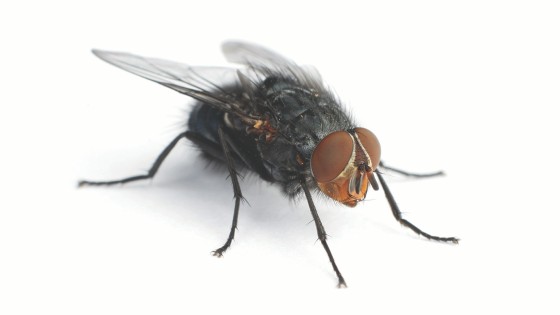Flies
Houseflies are very common worldwide and are often associated with human activity. They tend to be found wherever suitable conditions for breeding exist i.e. in moist organic matter.

Large numbers of flies tend to develop in certain environments such as intensive animal housing and refuse tips. As these populations expand they may spread into adjoining areas and then become a problem in local housing, restaurants etc.
Houseflies are known to transmit enteritis and parasitic worms and are also associated with the spread of typhoid and cholera.
Common House Fly
Latin name: | Musca domestica |
Length: | Approx. 6 - 8 mm |
Colour & description: | Have whitish eggs that are approx 1 mm in length. The larvae are white/yellow, feed in groups and are upto 12 mm long. The pupae are egg shaped and reddish in colour and are usually found in drier areas. Once emerged the adults are greyish with pale stripes on the thorax. They have large red eyes and are approx 6 mm in length. |
Habits & habitat: | Have a wide flight range of upto 5 miles and female house flies look to lay eggs in rotting, fermenting or moist organic matter. Rotting vegetable matter or animal faeces typically provide the ideal breeding site. |
Life cycle: | 1 to 4 weeks |
Reproduction rate: | During their adult life of 1-3 months a female is capable of producing 4-5 batches of 100-150 eggs. The eggs are laid in moist decaying matter and within 8 - 48 hours hatch into maggot larvae. They progress through 3 moults before they reach maturity which may take as little as 5 days but is dependent on the conditions. The pupa is then formed and some days later the adult emerges. |
Lesser House Fly
Latin name: | Fannia canicularis |
Length: | Approx. 3.5 - 6 mm |
Colour & description: | The eggs are a distinctive banana shape and approximately 1 mm in length. The larvae are upto 8 mm long and are grey/brown in colour. The pupae will tend to be located in drier locations and are darkly coloured. The adult has 3 longitudinal stripes on the thorax which are more pronounced in the male than the female and a yellowish abdomen. The adult is typically about 6 mm long. |
Habits & habitat: | The larvae feed on all types of decaying organic matter but they are commonly associated with food waste so are often found around bins and garbage depots as they provide ideal breeding sites. They may also be a pest within certain types of poultry housing. |
Life cycle: | 2 to 4 weeks |
Reproduction rate: | Eggs are usually laid in batches of about 50 with the females laying upto 2000 in their lifetime. The eggs are laid in moist decaying organic matter and within 24 - 48 hours hatch into maggot larvae. The larvae take approximately 6 days to reach pupation dependant on the conditions and it is usually 7 - 14 days before the adults emerge. |
BASF offers solutions to help you design a comprehensive, on-going fly control program that addresses flies at their source and provides immediate relief from adult flies.


